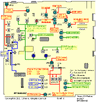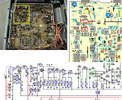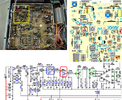Ok, so we will approach another way.
Just using a finger or if you're into "RED LASER" pointers use a temperature gun to measure heat produced.
Check the Driver -
Check the Pre Driver (those two actually)
Measure in AM/FM modes - then again using some type of tone or feedback "squeal" from a MONITOR radio nearby BFO'd to the SSB frequency
Compare the two modes - SSB to AM (or FM) and see what "Steady State" does then go to SSB modes using low-level to high level admittance (acceptance) ranges - when you lose power - depending on the kind of loss it can help you determine the method or tuning requirements.
When I mention "Low-Level; to High-Level admittances (acceptance)"
It is referring to how well the stage amplifies the signal - if the stage takes in the signal and amplifies it greatly - non-linearly - the thermal issue comes up when you exceed the admittance window of the input - you're saturating - and Flat-topping of the signal is a result - then the loss is from the BANDWIDTH of the signal it is supposed to amplify is exceeded - so heat is the conversion of the bandwidth loss and power loss is the result even though it's supply has not changed.
The Low-level to High level is the dynamic range of the stages' ability to accept and produce power linearly.
IF your losses are voltage or frequency based - you'd get heating because the amplifier is generating a lot more power in SSB than in AM or FM modes - it's not really supposed to do that. Means too much of one thing is making the stage heat up - so is it needing a tune up or do you have a capacitor in the Emitter leg with TOO much capacitance and is considered "leaky" and now makes the stage produce more power over a wider bandwidth?
If one stage produces more power in one particular mode but not in the other - think about the modes - one is steady state carrier - while another uses linear amplification which is dynamic - so if one stage or even the audio amp sending the power to the mixer is not up to snuff - a scope helps correct this but again Heat or lack thereof - shows which section works and the one that doesn't is the one that is way off temperature wise in one mode - but in the other mode of steady state - the stage will rise and stabilize quickly - far faster than the others or not rise at all until a demand is placed on it.
One stage remains cool but the stage after is the one that gets hot?
- Then consider the BIASING problem
- - if the hot stage is using Class - A - (Example - Predriver)
- - then suspect a bad resistor
- - not always - but most cases the stage QUITS working due to a open resistor - not a drifting one - so this puts the open resistor on the LOW side - the one that drags down the voltage until it opens then the BIAS voltage rises and all bets are off
- - while the positive rail one simply limits the current
- - so if the biasing is off - a voltage check reveals this
- - too low - the power rail resistor has opened,
- - too high - the low side or divider side of the rail is faulty.
In Carrier modes, the Driver and FINAL stages usually get warmer than the Predriver ones - simply due to the Steady State demand of carrier - so they will heat up but it's the consistency of the heating "Shared" versus one predominates over others that reveals what stage is operating non-linearly.
Scope would make this easy, but heat is a tell-tale for many ailments and the scope would help in the type of ailment - but in this case the simplicity is in the component selection, you only have two - as the example of the Pre-Drivers own Emitter leg - Resistor and Cap - just go measure and correctly install the replacements of the faulty parts.
That is the best advice I can give you...




